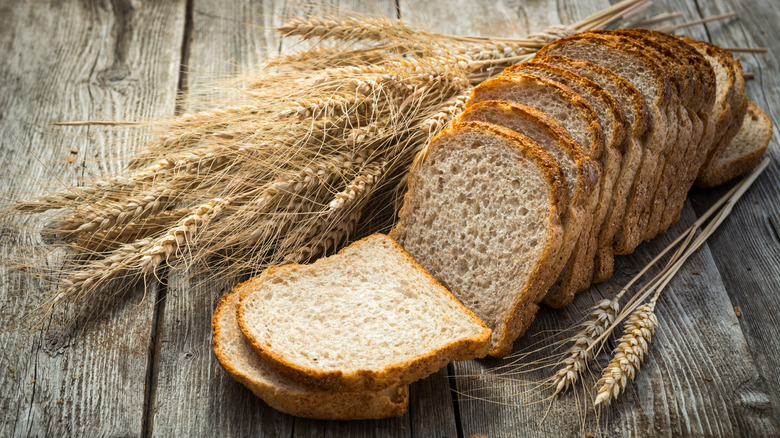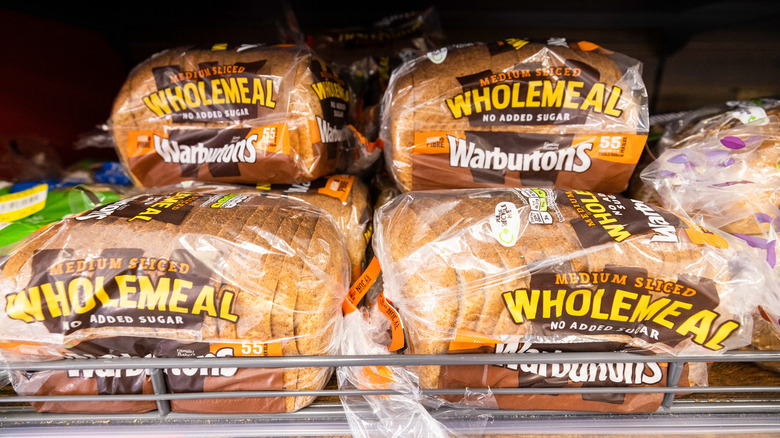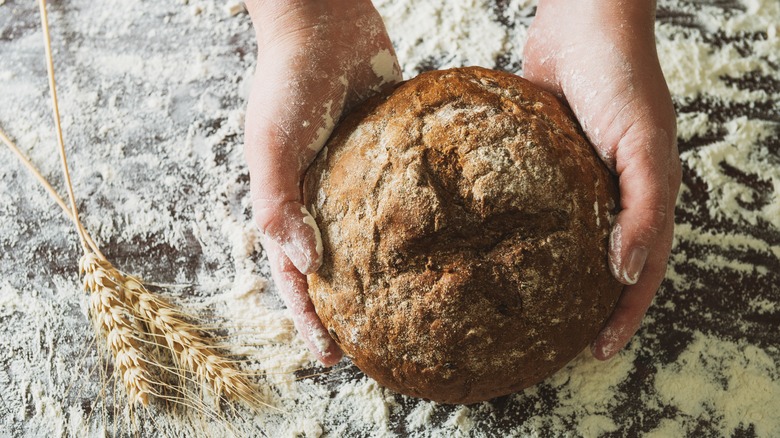The Ingredients You Need To Avoid When Buying Whole Wheat Bread
Swapping whole wheat bread for white bread sounds like a simple task, if you're trying to eat a more nutritious diet, but finding a "true" wheat bread can be difficult. First off, the choices can be overwhelming — just take a stroll down the bread aisle, where countless brands vie for your attention. You might wind up just grabbing any loaf that sounds reasonably healthy, but this leads you into the second pitfall: Brands can be sneaky with their jargon.
Just because a bread says "wheat" on the label doesn't mean it's all that different from white bread, which also happens to be made of wheat. There's no way around it: You're going to have to read the ingredients list closely. To ensure that you're getting a truly nutritious, whole wheat bread, the first ingredient listed on the label should be "whole wheat flour" or "100% whole wheat flour." This also should be the only flour listed.
Terms like "wheat flour" (unbleached or otherwise), "multigrain," "enriched," or "stone-ground wheat flour" are usually just refined white flour by a different name. In addition, you might also want to be on the lookout for any additives and extra ingredients that are designed to improve the flavor, texture, or shelf life of the bread. Remember, all it takes to make bread is flour, water, yeast, salt, and some sugar to feed the yeast, so if you want a loaf without any additives, a shorter ingredients list is your friend.
What to look for in your bread
If the ingredient list on your loaf of wheat bread begins with 100% whole wheat or whole wheat flour, you're off to a good start. Other indicators of nutritious bread are a fiber content of three to five grams per serving, a protein content of three to six grams, and no added sweeteners. Aside from sugar, sweeteners on the ingredients list may include honey, high-fructose corn syrup, or evaporated cane juice. These ingredients are fine when used in small amounts, but if your bread contains more than three grams of sugar per serving, it may be excessively sweetened.
Generally, the most nutritious wheat bread will contain no more than 100 calories per slice. And bread that is made with 100% whole wheat is not the only nutritionally-dense bread you can buy. Other loaves offer different textures and flavors and can be an exciting part of a healthful diet — try looking for sprouted whole grain, sourdough, flax bread, and 100% sprouted rye bread. Again, just check the labels to make sure you're getting whole wheat flour, little to no sugar, and minimal preservatives.
Where to find the most nutritious bread
One of the best ways to make sure your bread contains nutritious ingredients with no unnecessary additives is to make your own. Because homemade bread tends to lack preservatives, you'll need to eat it or freeze it quickly, but besides this caveat, it's superior in almost all ways to mass-produced supermarket loaves. Prefermenting your homemade bread will also keep your loaves fresher for longer.
If you have leftovers, just cut the loaf into slices and freeze each one individually before placing the slices in a container or bag in the freezer. You can then defrost slices as you need them. Another option is to buy bread from a reputable bakery that bakes its loaves fresh daily, or even at a weekly farmers' market. The purveyor should be able to tell you exactly what's in the bread they are selling.
If store-bought bread is the most convenient choice for you, you now know what to look for and what to avoid if nutrition is high on your priority list. As a final tip, some nutritious wheat breads may be found not in the bread aisle, but the freezer aisle, because of their lack of shelf-stabilizing preservatives.



